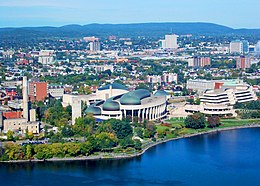
Back Gatineau Afrikaans غاتينو (كيبك) Arabic Gatineau AST Katino ATJ گاتینو AZB Гатыно Byelorussian Гатыно BE-X-OLD Гатино Bulgarian Gatineau Catalan Gatineau (lungsod sa Kanada) CEB
Gatineau
Ville de Gatineau | |
|---|---|
| Ville de Gatineau | |
Clockwise from top left: Canadian Museum of History, downtown, Ottawa River, Rue de l'Hôtel-de-Ville, and Macdonald-Cartier Bridge. | |
|
| |
| Nickname: G-town | |
| Motto(s): Fortunae meae, multorum faber[1] ("Maker of my fate and that of many others") | |
 Location of Gatineau (red) with adjacent municipalities | |
| Coordinates: 45°29′N 75°39′W / 45.483°N 75.650°W[2] | |
| Country | Canada |
| Province | Quebec |
| Region | Outaouais |
| RCM | None |
| Constituted | 1 January 2002 |
| Government | |
| • Type | Gatineau City Council |
| • Mayor | Daniel Champagne (acting) |
| • Federal riding | Gatineau / Hull—Aylmer / Pontiac / Argenteuil—La Petite-Nation |
| • Prov. riding | Chapleau / Gatineau / Hull / Papineau / Pontiac |
| Area | |
| • City | 381.30 km2 (147.22 sq mi) |
| • Land | 342.98 km2 (132.43 sq mi) |
| • Metro | 2,999.90 km2 (1,158.27 sq mi) |
| Population (2021)[6] | |
| • City | 291,041 |
| • Density | 773.7/km2 (2,004/sq mi) |
| • Metro | 1,488,307 |
| • Metro density | 104.8/km2 (271/sq mi) |
| • Pop 2011–2016 | |
| • Dwellings | 125,608 |
| Time zone | UTC−5 (EST) |
| • Summer (DST) | UTC−4 (EDT) |
| Postal code(s) | J8L, J8M, J8P, J8R, J8T, J8V, J8X to J8Z, J9A, J9H to J9J, various K1A (Government Offices) |
| Area codes | 819, 873 |
| GDP Per Capita | CAD$ 38 079 (2018) |
| Website | www |
Gatineau (/ˈɡætɪnoʊ/ GAT-in-oh; French: [ɡatino]) is a city in southwestern Quebec, Canada. It is located on the northern bank of the Ottawa River, immediately across from Ottawa, Ontario. Gatineau is the largest city in the Outaouais administrative region of Quebec and is also part of Canada's National Capital Region. As of 2021, Gatineau is the fourth-largest city in Quebec with a population of 291,041,[6][7] and it is part of the Ottawa-Gatineau census metropolitan area with a population of 1,488,307 making it the fourth largest in Canada.[8][9][10]
Gatineau is coextensive with a territory equivalent to a regional county municipality (TE) and census division (CD) of the same name, whose geographical code is 81. It is the seat of the judicial district of Hull.[11]
It is also the most bilingual (French-English) city in Canada.[12]
- ^ "Ville de Gatineau (1933–1974) – Armoiries". Archived from the original on 8 August 2014. Retrieved 19 June 2013.
- ^ Cite error: The named reference
toponymiewas invoked but never defined (see the help page). - ^ a b Cite error: The named reference
mamrotwas invoked but never defined (see the help page). - ^ Cite error: The named reference
cp2011was invoked but never defined (see the help page). - ^ Ottawa – Gatineau (Quebec part) (Census metropolitan area), 2011 Census profile Archived 6 August 2020 at the Wayback Machine. The census metropolitan area (Quebec part) consists of Gatineau, Bowman, Cantley, Chelsea, Denholm, L'Ange-Gardien, La Pêche, Mayo, Notre-Dame-de-la-Salette, Pontiac, Val-des-Bois, Val-des-Monts. In the 2006 census, the census metropolitan area had not included Bowman, Mayo, Notre-Dame-de-la-Salette, Val-des-Bois.
- ^ a b "Gatineau (Code 2466023) Census Profile". 2016 census. Government of Canada - Statistics Canada.
- ^ "2021 Census". Statistics Canada. Government of Canada. 9 February 2022. Archived from the original on 25 August 2022. Retrieved 25 August 2022.
- ^ Canada, Government of Canada, Statistics (8 February 2017). "Census Profile, 2016 Census – Ottawa – Gatineau (Quebec part) [Census metropolitan area], Quebec and Quebec [Province]". www12.statcan.gc.ca. Archived from the original on 7 August 2020. Retrieved 2 June 2017.
{{cite web}}: CS1 maint: multiple names: authors list (link) - ^ Canada, Government of Canada, Statistics (8 February 2017). "Census Profile, 2016 Census – Ottawa – Gatineau [Census metropolitan area], Ontario/Quebec and Ontario [Province]". www12.statcan.gc.ca. Archived from the original on 24 September 2019. Retrieved 22 June 2017.
{{cite web}}: CS1 maint: multiple names: authors list (link) - ^ "2021 CMA Census". Statistics Canada. Government of Canada. 9 February 2022. Archived from the original on 25 August 2022. Retrieved 25 August 2022.
- ^ Territorial Division Act Archived 26 September 2018 at the Wayback Machine. Revised Statutes of Quebec D-11.
- ^ Government of Canada, Statistics Canada (21 June 2023). "English–French bilingualism in Canada: Recent trends after five decades of official bilingualism". www12.statcan.gc.ca. Retrieved 17 November 2023.
© MMXXIII Rich X Search. We shall prevail. All rights reserved. Rich X Search








